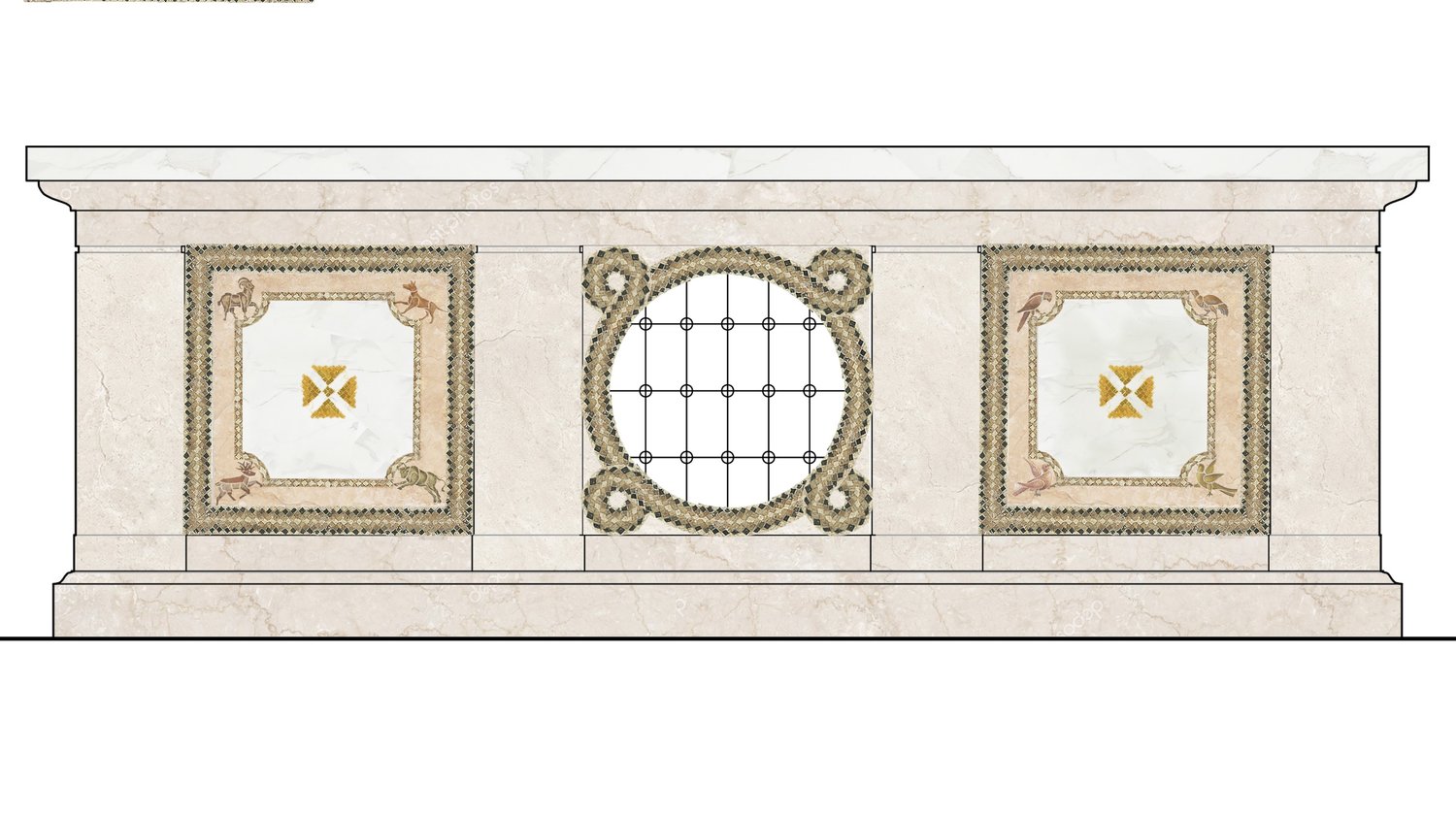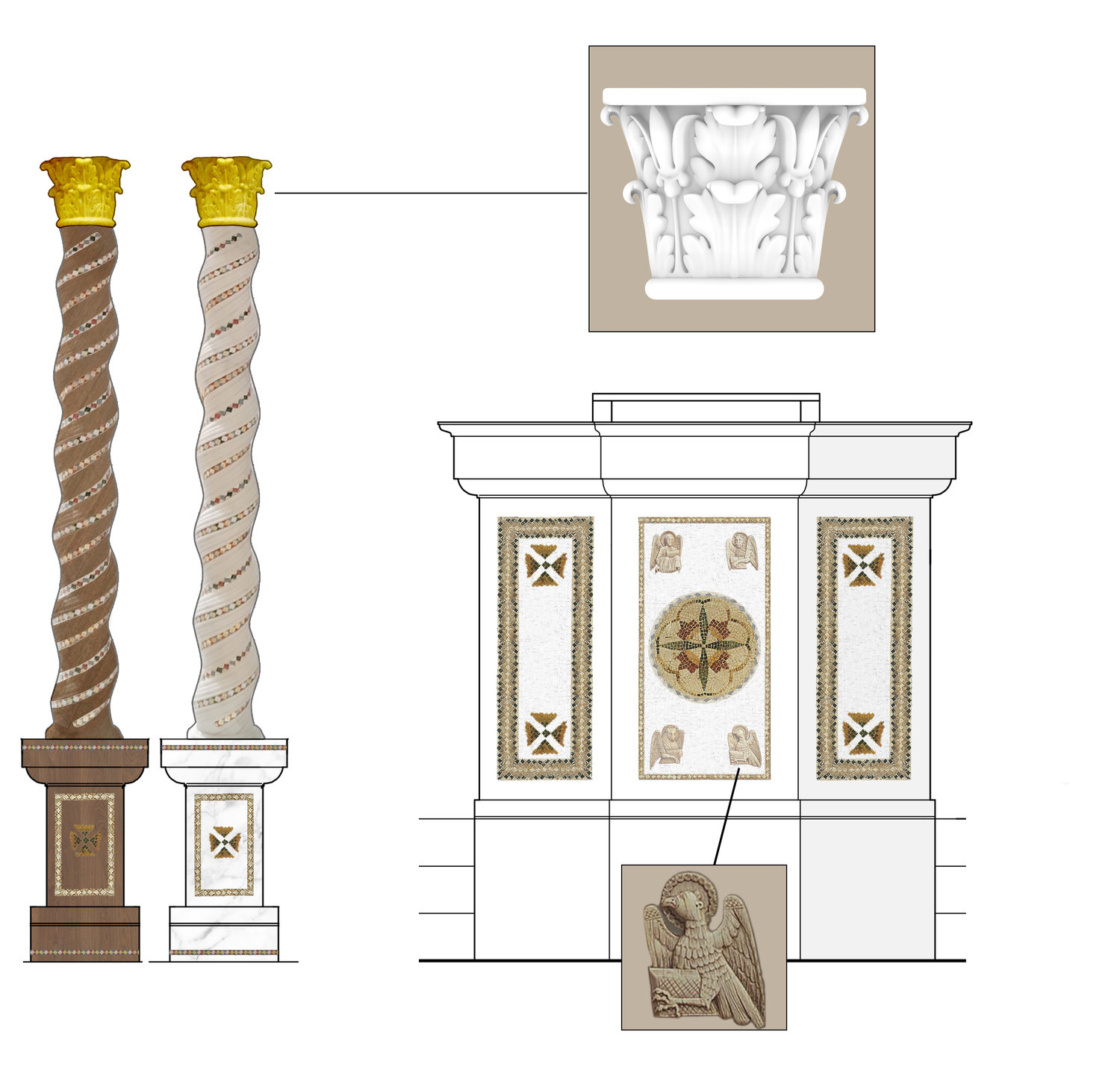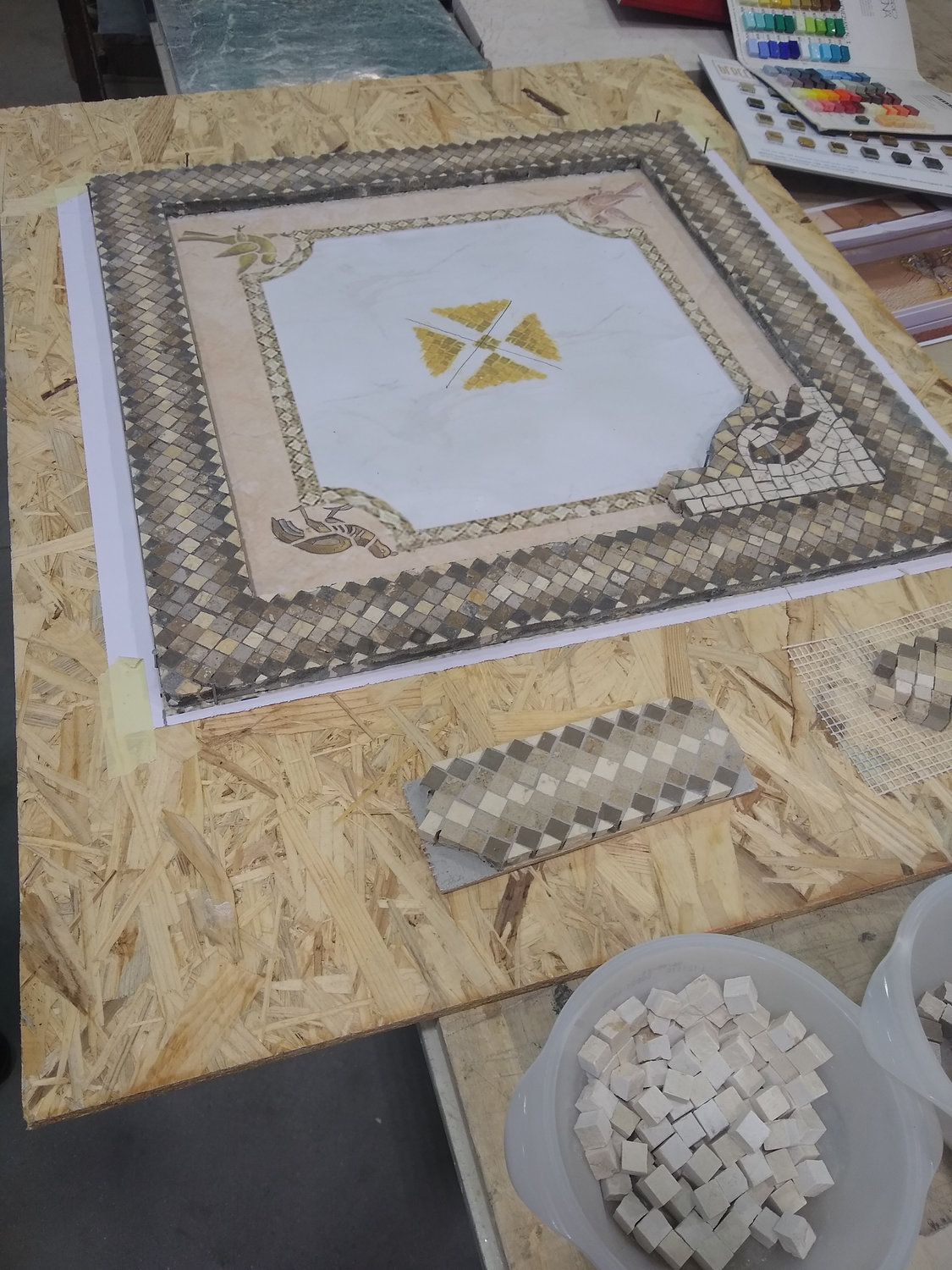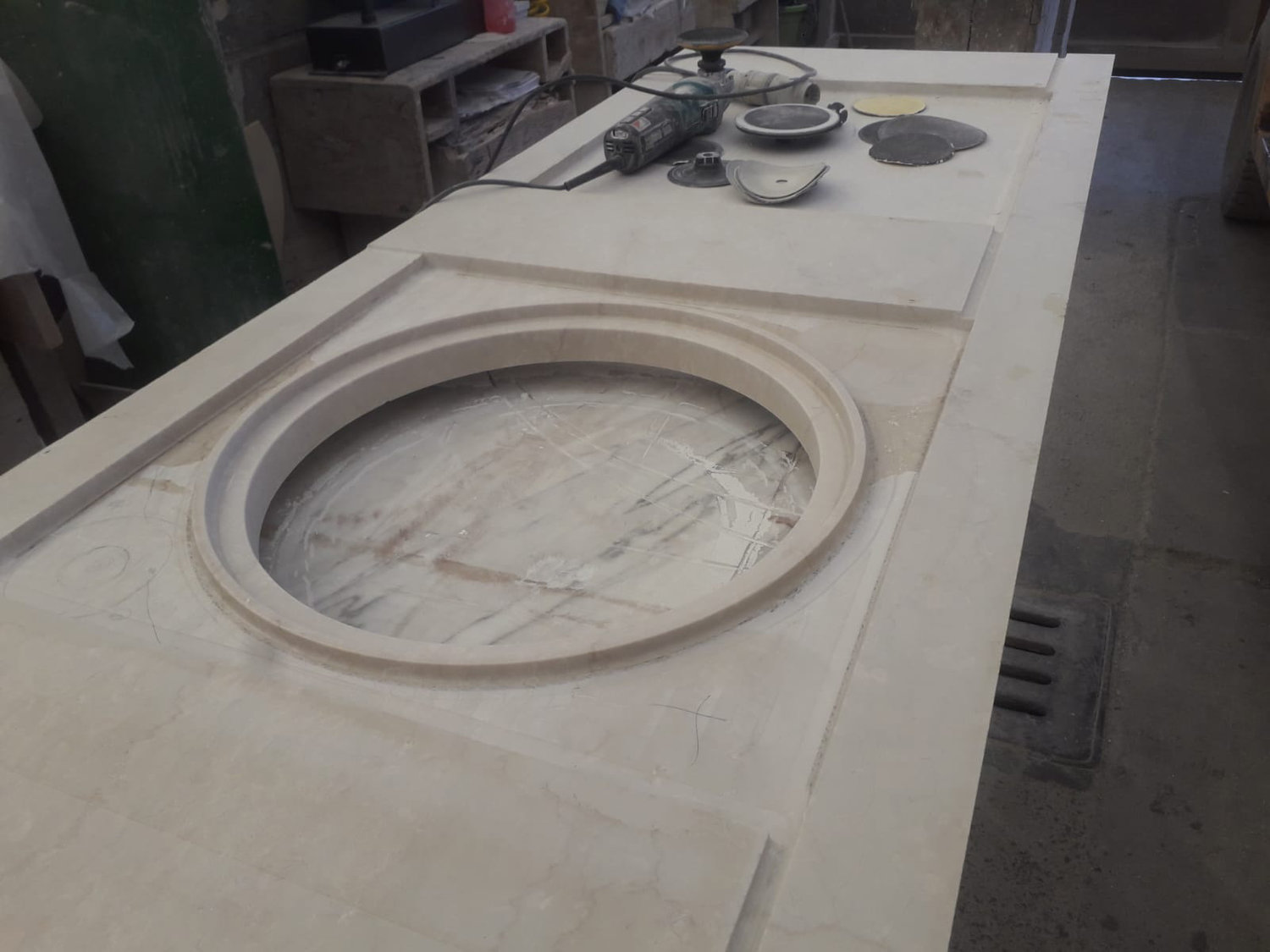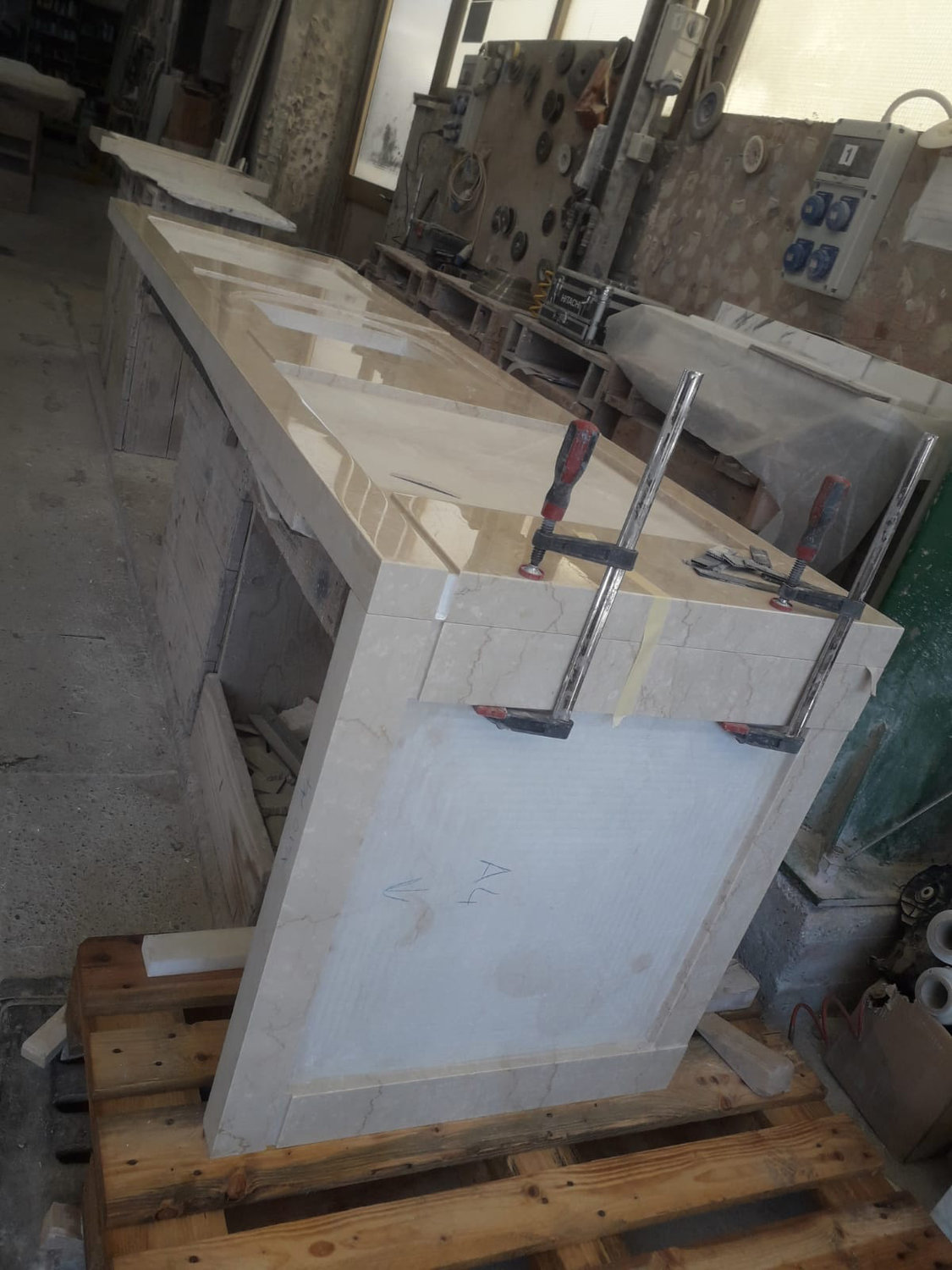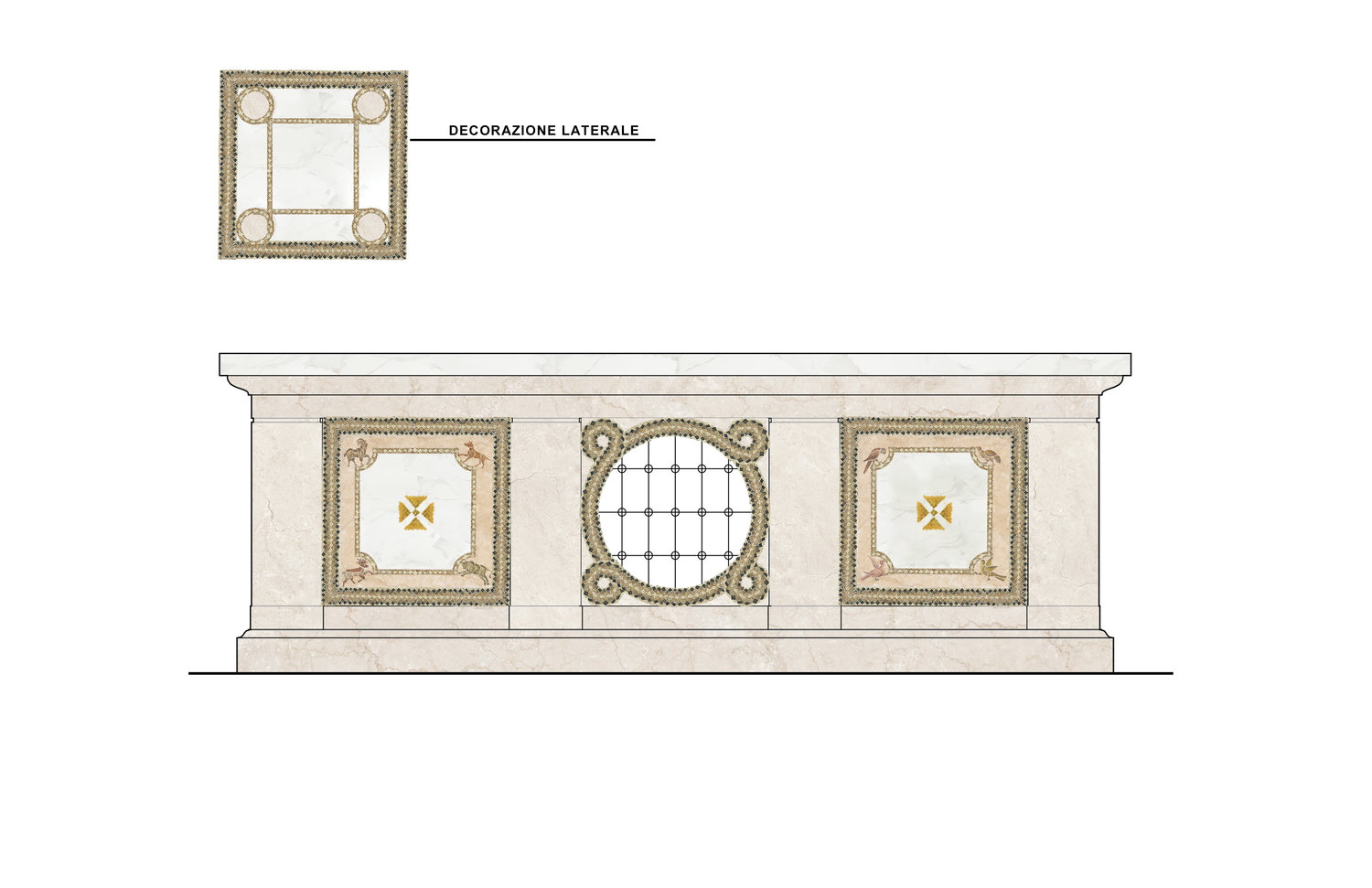Cathedral’s new altar, ambo will reinforce important truth

Images of the Garden of Eden harken back to a time when all creatures were in right relationship with God and one another.
Christ restored that relationship through His life, death and resurrection, opening the door to a new Eden in the heavenly kingdom of His Father.
Hence the artwork that will embellish the new altar being created for the Cathedral of St. Joseph in Jefferson City.
It is part of a substantial, yearlong renovation, expansion and renewal of the 53-year-old Cathedral, focused on enhancing its beauty, functionality, capacity for hospitality and uniquely Catholic identity.
Artisans in Verona, Italy, are creating mosaics that will fill the panels on all four sides of the Botticino marble altar.
“They depict fauna — mostly birds but also deer and other symbols of life and the fruits of God’s creation,” said church architect William Heyer, architectural consultant for the renovation project, who designed the altar.
Citing centuries of precedent, Bishop W. Shawn McKnight called for the fauna to be included in the altar’s artwork.
“It’s a tradition that goes back far into Church history,” Mr. Heyer noted, “where things from the original Garden of Eden are depicted, because the sanctuary is the new Garden of Eden.
“The fact that it’s all depicted on the altar is a symbol of new life created by Him Who is present on the altar,” said Mr. Heyer.
The mosaic designs will be simple and vividly colored, contributing to an overall balance of decoration and decorum.
“The bishop wants to be sure we’re doing something tasteful and elegant but not extravagant,” Mr. Heyer noted. “I think that’s fitting for this particular cathedral and its style and also the bishop’s desire to have people focus on the heavenly Liturgy with a healthy sense of decorum.”
In anticipation of Pentecost (June 5) and the Solemnity of The Body and Blood of Christ (June 19), Mr. Heyer talked about the altar and ambo that are being created in Italy for the Cathedral.
He said the proper design of a church and its components is focused first on proper worship.
He noted that many Scriptural antecedents for communal worship echo the Book of Leviticus, in which God instructs the Israelites how to keep Him at the center of their lives after He delivered them from bondage.
“He clearly demands that we worship Him a certain way,” Mr. Heyer noted. “There’s an order, or rule, that’s given, and if we follow it, then we will be blessed.
“So the right worship of God produces blessing,” he continued. “The wrong worship of God produces no blessings. We have to do it right.”
Toward that end, the designs of each new element of the Cathedral’s sanctuary is being given scrupulous attention.
“None of this is whimsical,” Mr. Heyer insisted. “There’s always a reason for the shapes, the geometry, the proportion, the materials, the artwork, the symbols — it all has a meaning down to the simplest piece of stone.”
Symbol of the whole Christ
It stands to reason that the altar, given its sacred function, must be the focal point in any Catholic church.
Universal directives from the Vatican call for a dedicated altar to be made of natural materials, preferably stone, and secured to the floor.
In keeping with the ancient tradition of offering Mass over the burial places of saints and martyrs, each altar may contain relics of recognized saints of the Church.
Weighing about 2.75 tons, this new altar will be somewhat larger than the one that adorned the Cathedral since its completion in 1968.
Its size is proportional to the place it holds in the sanctuary.
“Of course, it is a symbol of the tomb into which Christ was laid,” Mr. Heyer pointed out. “It also has significance because it carries on an image of sacrifice from the Holy Temple.”
Likewise, it is the place upon which Christ becomes fully present in the celebration of the Eucharist, “just as He was in the crèche in Bethlehem.”
So there are hints of Jesus’s birthplace and the place of His crucifixion and death at Golgotha and of his burial and resurrection nearby.
“You really bookend His earthly life with the altar,” said Mr. Heyer. “So the symbol of the altar is a symbol of the whole Christ, and that is very powerful. It helps us to reinvigorate our understanding of the Eucharist.”
Altar and table
The altar is being fashioned of Botticino marble for the base and Lasa Veno Oro marble for the altar top, or mensa.
It will be 9-and-a-half feet wide and 40 inches tall.
The most important part is the mensa. This is the portion of the altar Bishop McKnight will consecrate with the Oil of Sacred Chrism.
It will be where the Body and Blood of Christ is made present and offered back to the Father as the perfect sacrifice in response to Jesus’s own words: “Do This in remembrance of Me.”
From there, Jesus will offer Himself as food to nourish and heal the souls of all who receive Him in a state of grace.
“It is at once both altar and table — that is important,” said Mr. Heyer. “We have the opportunity to reinforce our understanding of the Eucharist by bringing back these other symbols.”
The portion of the altar below the mensa is the base. Its dimensions and imagery are reminiscent of an ancient sarcophagus. But instead of a body being laid to rest within, there will be authenticated relics of saints, encased in a reliquary that will be visible through an iron grille on the front of the altar.
These will include the relics that were placed in the previous altar at the time of its consecration, as well as several others.
Eight sides
The ambo, where the Gospel will be proclaimed and homilies preached at Mass, will be made of White Oak and adorned with marble mosaics.
Like the new baptismal font, it will have eight sides — representing the six days of Creation, the Sabbath, and the day on which Jesus rose from the dead.
The ancient anthropomorphic images of the four Evangelists will be carved in stone and placed in the mosaic panel on the front of the ambo. Simpler mosaics will embellish the other panels.
The ambo will be at the same level as the rest of the sanctuary but will project out over the stairs like the prow of a ship.
It will stand on the side of the sanctuary opposite the new cathedra (bishop’s chair) — symbol of his teaching authority — from which a cathedral gets its name.
A substantial stand for the Paschal Candle, a symbol of the risen Christ, will be placed next to the ambo.
It will be what’s known as a Solomonic column, reminiscent of the corkscrew-shaped columns believed to have been created for the original Temple built by King Solomon in Jerusalem.
The design for the column also mirrors the pillar of fire through which God protected His people during their escape from slavery in Egypt and during their time in the desert.
Four large Solomonic columns support the baldachino over the altar in St. Peter’s Basilica in Vatican City.
Gospels in stone
Mr. Heyer has read articles about young people around the world who were raised with little or no faith, encountering Christ and being drawn toward His Church by visiting a cathedral.
“In our culture, we sometimes forget that the building itself is a sacramental and can shed grace on people,” he said.
The major elements of a Cathedral sanctuary, as they relate most closely to the celebration of the Liturgy, carry special weight in instructing the faithful each time they gather for Mass.
“Which is why we have to be sure to do these things right,” said Mr. Heyer.
He said the rich symbolism contained in this Cathedral’s new sanctuary will help teach people about the nature of Christ.
“It’s an opportunity to reveal the Word, not just through the proclamation of the Gospel but through the actual structure itself,” he stated.
Many priests of the diocese have made pledges to pay for the new altar.
Many permanent deacons have made pledges toward the cost of the new ambo.
Since the Cathedral serves everyone in the diocese, Bishop McKnight invites Catholics from all parishes to contribute toward the cost of the renovation, as long as doing so does not reduce their regular, sacrificial support of their own parish.
Visit diojeffcity.org/cathedral-renovation for information.
Comments
Other items that may interest you
Services
The Catholic
Missourian
2207 W. Main St.
Jefferson City MO 65109-0914
(573) 635-9127
editor@diojeffcity.org

